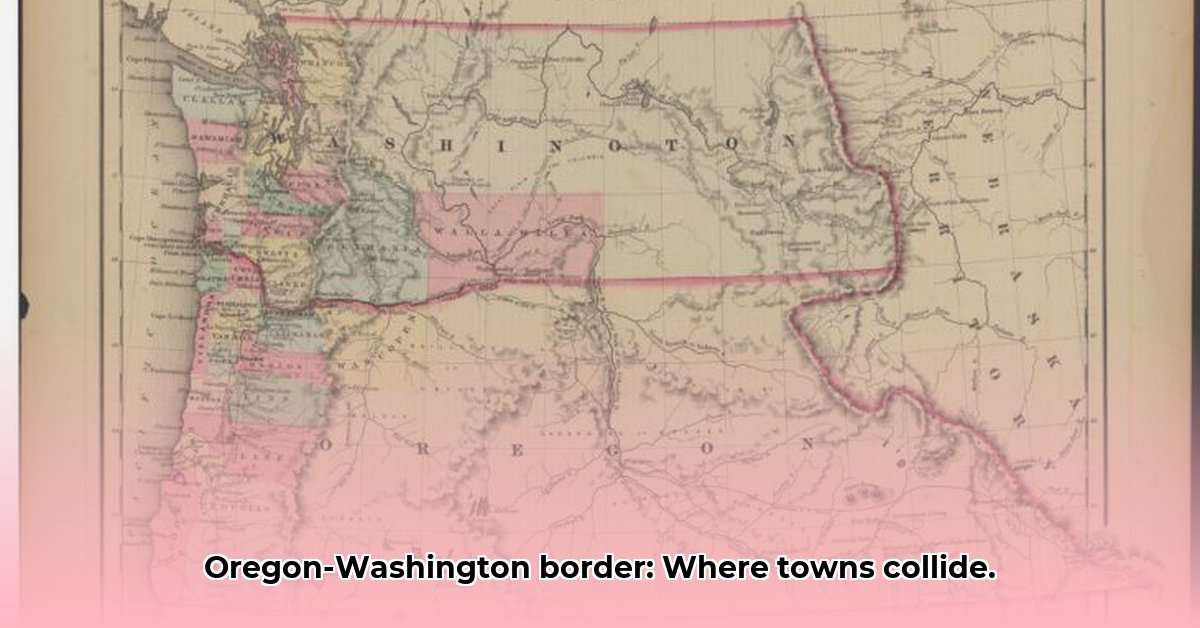
The Oregon-Washington border, far from being a mere line on a map, is a dynamic zone where two states intertwine, shaping the lives and economies of the towns that call this region home. For a detailed map of the border region, see this Oregon-Washington map. This article explores the unique challenges and opportunities presented by this shared border, focusing on the towns nestled along its length and how their proximity affects their identity, economy, and daily life.
Exploring the Geographic Landscape
The Oregon-Washington border stretches for hundreds of miles, often following the meandering course of the mighty Columbia River. Imagine the river as a natural, sometimes winding, sometimes straight, boundary, separating – and simultaneously connecting – Oregon and Washington. In other areas, the border traverses flatter terrain, creating a less defined transition between states. This diverse geography results in a variety of communities with unique characteristics, each with its individual story to tell.
Border Towns: A Diverse Tapestry
The towns along the Oregon-Washington border are not just dots on a map; they are vibrant communities with distinctive characters shaped by their proximity to the state line. Categorizing them by distance from the border offers a glimpse into their commonalities and differences. Remember, this is a simplification; the lived experience of border residents is far richer and more nuanced.
| Distance from Border | Oregon Towns | Washington Towns | Notes |
|---|---|---|---|
| Less than 1 mile | Astoria, Rainier | Puget Island, Skamokawa | High integration; residents frequently cross for daily activities. |
| 1-2 miles | Clatskanie, Knappa | Cathlamet, Wahkiakum | Strong economic and social ties despite slightly greater separation. |
| Greater than 2 miles | St. Helens (partially), Prescott | Goldendale, White Salmon (partially) | Still influenced by border proximity, through trade, resources, and culture. |
(This table represents a selection; many more towns exist along the border.)
The Ripple Effect: Societal and Economic Impacts
The border's influence extends far beyond its geographic location, significantly shaping the social and economic landscapes of these towns. Daily commutes across state lines are common, creating a unique blend of cultures and perspectives. But this interconnectedness also presents challenges. How do differing state regulations impact businesses? How does the constant cross-border flow of people shape the regional identity?
Commuting Patterns
The ease (or difficulty) of commuting across the border profoundly impacts the lives of border residents. For many, a daily trip across the state line is essential for work, shopping, or education. This cross-border flow of people creates a unique dynamic, fostering a sense of shared community that transcends state boundaries. But it also raises questions about transportation infrastructure and the need for efficient, reliable, and affordable cross-border transit solutions.
Economic Interdependence
The economies of these border towns are significantly intertwined. Goods, services, and labor move freely across the border, creating a complex web of economic interdependence. This shared reliance also presents challenges. Economic fluctuations in one state can rapidly affect the other, highlighting the need for regional economic planning and collaboration. "Businesses must be adaptable and resilient," says Dr. Anya Sharma, Professor of Economics at Portland State University. "The constant fluidity of the border requires a specific set of strategies."
Shared Identities
Living in a border region often fosters a sense of shared identity that surpasses state lines. Residents may identify more with the broader regional culture than with the specific state they reside in. This shared sense of belonging is strengthened by social interactions, cultural events, and common challenges faced by border communities. Residents often see themselves as part of a larger community, their identity intertwined with the region's unique character, rather than simply defined by state lines.
Collaboration: Bridging the Divide, Building the Future
Addressing the challenges and realizing the vast potential of this border region requires significant collaboration between Oregon and Washington. Streamlined emergency services, efficient resource management, and joint tourism initiatives could significantly improve the quality of life and stimulate regional economic growth.
Harmonizing Regulations: A Catalyst for Growth
One significant challenge is the inconsistency of state regulations, particularly impacting businesses. Harmonizing these regulations, or at least finding ways to streamline cross-border interaction, would significantly reduce burdens on businesses and foster a more robust, interconnected economy. "Inconsistency in regulations creates unnecessary hurdles for businesses and stifles economic potential," notes Mr. David Miller, Director of the Washington State Department of Commerce. "Collaborative efforts to resolve these inconsistencies are crucial for regional economic health."
Investing in Infrastructure: A Foundation for Progress
Investing in modern, efficient infrastructure, particularly transportation, is essential for the continued growth of border communities. Improved roads, bridges, and public transportation will improve commuting times and enhance the free flow of goods and services across the state line, benefiting both residents and businesses.
Key Takeaways:
- Interconnectedness: Oregon and Washington border towns are deeply intertwined through daily commutes, economic activity, and shared cultural experiences.
- Regulatory Harmonization: Streamlining regulations is crucial for fostering economic growth and reducing administrative burdens for businesses.
- Collaborative Solutions: Regional planning and cooperation between Oregon and Washington are essential for addressing unique challenges and maximizing opportunities.
This article provides a glimpse into the vibrant complexities of the Oregon-Washington border region. Further research and ongoing dialogue are essential to fully understand and address the unique dynamics of this interwoven landscape.